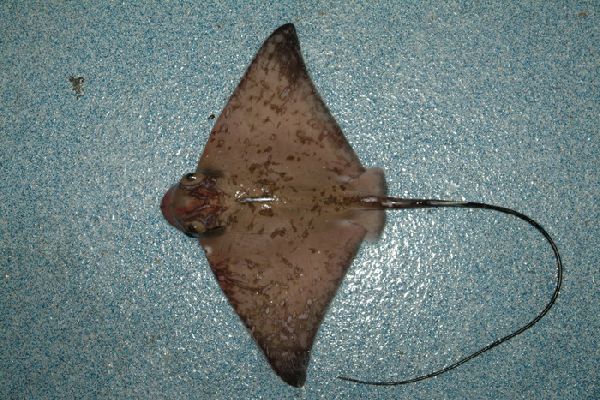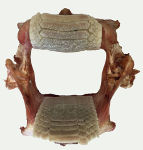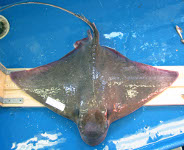Myliobatis freminvillei
Lesueur, 1824
Bullnose eagle ray
Classification: Elasmobranchii Myliobatiformes Myliobatidae
Reference of the original description
Description of several species of the Linnaean genus Raia of North America. Journal of the Academy of Natural Sciences of Philadelphia, 4(1), 100–121
Description of several species of the Linnaean genus Raia of North America. Journal of the Academy of Natural Sciences of Philadelphia, 4(1), 100–121
Image of the original description
No image in first description.
No image in first description.
Synonyms / new combinations and misspellings
Aetobatis freminvillii, Aetobatus freminvilli, Aetobatus freminvillii, Myliobatis acuta, Myliobatis bispinosus, Myliobatis fremenvillei, Myliobatis freminville, Myliobatis freminvillii
Aetobatis freminvillii, Aetobatus freminvilli, Aetobatus freminvillii, Myliobatis acuta, Myliobatis bispinosus, Myliobatis fremenvillei, Myliobatis freminville, Myliobatis freminvillii
Types
Myliobatis freminvillei
Myliobatis acuta
XXXX: No types known;
Myliobatis bispinosus
Holotype: MCZ: 89509 (missing)
Myliobatis freminvillii
XXXX: No types known;
Myliobatis freminvillei
Myliobatis acuta
XXXX: No types known;
Myliobatis bispinosus
Holotype: MCZ: 89509 (missing)
Myliobatis freminvillii
XXXX: No types known;
Description :
Citation: Myliobatis freminvillei Lesueur, 1824: In: Database of modern sharks, rays and chimaeras, www.shark-references.com, World Wide Web electronic publication, Version 12/2025
Please send your images of "Myliobatis freminvillei" to info@shark-references.com

Myliobatis freminvillii Lesueur, 1824, © NOOA www.photolib.noaa.gov/

Myliobatis freminvillii Lesueur, 1824, © NOOA www.photolib.noaa.gov/
Common names
 Bullnose eagle ray,
Bullnose eagle ray,  Chucho,
Chucho,  Chucho blanco,
Chucho blanco,  Águila naríz de vaca,
Águila naríz de vaca,  Aigle de mer taureau,
Aigle de mer taureau,  Blue-nosed ray,
Blue-nosed ray,  Bullnose eagle ray,
Bullnose eagle ray,  Bullnose ray,
Bullnose ray,  Eagle ray,
Eagle ray,  Longtail stingray,
Longtail stingray,  Raie aigle,
Raie aigle,  Sharpnosed ray,
Sharpnosed ray,  Stingree,
Stingree,  Arraia-amarela,
Arraia-amarela,  Arraia-sapo,
Arraia-sapo,  Raia-sapo,
Raia-sapo,  Raia-touro
Raia-touro
 Bullnose eagle ray,
Bullnose eagle ray,  Chucho,
Chucho,  Chucho blanco,
Chucho blanco,  Águila naríz de vaca,
Águila naríz de vaca,  Aigle de mer taureau,
Aigle de mer taureau,  Blue-nosed ray,
Blue-nosed ray,  Bullnose eagle ray,
Bullnose eagle ray,  Bullnose ray,
Bullnose ray,  Eagle ray,
Eagle ray,  Longtail stingray,
Longtail stingray,  Raie aigle,
Raie aigle,  Sharpnosed ray,
Sharpnosed ray,  Stingree,
Stingree,  Arraia-amarela,
Arraia-amarela,  Arraia-sapo,
Arraia-sapo,  Raia-sapo,
Raia-sapo,  Raia-touro
Raia-touro
Short Description
Disk broad with long sharply pointed wings and projecting snout. Tail very long, Few middorsal spines on disk in adults [17658]. Greyish, reddish chocolate or dusky brown above. Lower surface either pure white or whitish. Teeth green [199].
Disk broad with long sharply pointed wings and projecting snout. Tail very long, Few middorsal spines on disk in adults [17658]. Greyish, reddish chocolate or dusky brown above. Lower surface either pure white or whitish. Teeth green [199].
Distribution
Western Atlantic: continental waters from Cape Cod to southeastern Florida (?) in the USA; also southern Brazil to Argentina [5839]. Reported (but not known for certain) from Gulf of Mexico, Florida and Caribbean islands, and northern South America. Often confused with Myliobatis goodei [7174]. Source: www.gbif.org
Western Atlantic: continental waters from Cape Cod to southeastern Florida (?) in the USA; also southern Brazil to Argentina [5839]. Reported (but not known for certain) from Gulf of Mexico, Florida and Caribbean islands, and northern South America. Often confused with Myliobatis goodei [7174]. Source: www.gbif.org
Human uses
fisheries: minor commercial; price category: medium; price reliability: very questionable: based on ex-vessel price for species in this family
fisheries: minor commercial; price category: medium; price reliability: very questionable: based on ex-vessel price for species in this family
Biology
Exhibit ovoviparity (aplacental viviparity), with embryos feeding initially on yolk, then receiving additional nourishment from the mother by indirect absorption of uterine fluid enriched with mucus, fat or protein through specialised structures [733]. Found frequently in coastal waters to 10 m depth, mainly in shallow estuaries. Capable of travelling long distances, occasionally leaps out of the water. Swims in midwater. Cruises slowly over the bottom, rooting out bivalves with its beak and wings when feeding.
Exhibit ovoviparity (aplacental viviparity), with embryos feeding initially on yolk, then receiving additional nourishment from the mother by indirect absorption of uterine fluid enriched with mucus, fat or protein through specialised structures [733]. Found frequently in coastal waters to 10 m depth, mainly in shallow estuaries. Capable of travelling long distances, occasionally leaps out of the water. Swims in midwater. Cruises slowly over the bottom, rooting out bivalves with its beak and wings when feeding.
Remarks
shark-references Species-ID=3905;
shark-references Species-ID=3905;
Parasites (arranged by Jürgen Pollerspöck)
Myxosporea
Monogenea
Cestoda
Hirudinea
Myxosporea
- Kudoa sp. [22052]
Monogenea
Cestoda
- Acanthobothrium paulum Linton, 1890 [16448]
- Caulobothrium longicolle (Linton, 1890) [16247]
- Nybelinia sp. [16112]
- Tetrarhynchobothrium unionifactor (Shipley & Hornell, 1904) [16112]
Hirudinea
- Branchellion torpedinis Savigny, 1822 [25687]


















